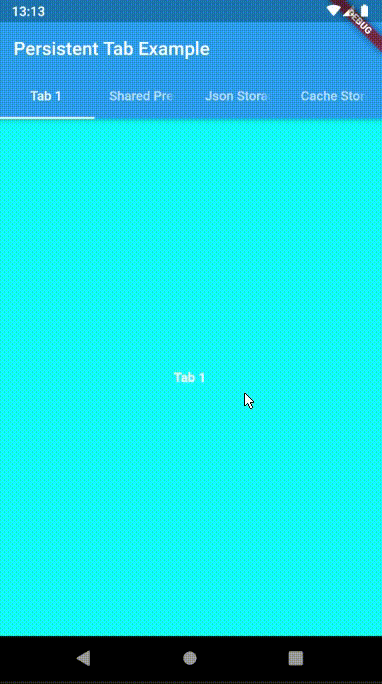States are typically stored in local storage so that a user's activity on an application can appear to be persistent
state_persistence package enables to store data as a local JSON file called data.json in the applications data directory
It can also be integrated with some other type of storage like Firebase
Check Flutter installation to setup Flutter
Use flutter create command to create a Flutter project (here local_storage_app :
flutter create local_storage_app Add state_persistence package to pubspec.yaml
dependencies:
state_persistence:
flutter:
sdk: flutter
Run following command to add dependency
flutter pub getimport 'package:state_persistence/state_persistence.dart'; In entry widget, wrap MaterialApp as child of PersistedAppState
Assign storage property to JsonFileStorage with optional initialData
storage can also be instance of some other storage class which extends PersistedStateStorage
class PersistentStorageApp extends StatelessWidget {
@override
Widget build(BuildContext context) {
return PersistedAppState(
storage: JsonFileStorage(initialData: {
'tab': 1,
}),
child: MaterialApp(
title: 'Persistent Storage Example App',
theme: ThemeData(primarySwatch: Colors.blue),
home: EgWidget(),
),
);
}
}PersistedData object Use PersistedAppState.of() method to get PersistedData instance for context
@override
void didChangeDependencies() {
super.didChangeDependencies();
PersistedData _data = PersistedAppState.of(context);
// get value for key 'tab'
var _initialIndex = _data['tab']
}
// set value
_data['tab'] = 0Data that is set to PersistedData is saved to disk based on the saveTimeout given to the PersistedAppState widget whose default value is 500 milliseconds
Example of builder :
import 'package:flutter/material.dart';
import 'package:state_persistence/state_persistence.dart';
void main() => runApp(App());
class App extends StatefulWidget {
@override
_AppState createState() => _AppState();
}
class _AppState extends State<App> {
TextEditingController _textController;
@override
Widget build(BuildContext context) {
return PersistedAppState(
storage: JsonFileStorage(),
child: MaterialApp(
title: 'Persistent TextField Example',
theme: ThemeData(primarySwatch: Colors.indigo),
home: Scaffold(
appBar: AppBar(title: Text('Persistent TextField Example')),
body: Container(
padding: const EdgeInsets.all(32.0),
alignment: Alignment.center,
child: PersistedStateBuilder(
builder: (BuildContext context, AsyncSnapshot<PersistedData> snapshot) {
if (snapshot.hasData) {
if (_textController == null) {
_textController = TextEditingController(text: snapshot.data['text'] ?? '');
}
return TextField(
controller: _textController,
decoration: InputDecoration(
hintText: 'Enter some text',
),
onChanged: (String value) => snapshot.data['text'] = value,
);
} else {
return CircularProgressIndicator();
}
},
),
),
),
),
);
}
}import 'dart:async';
import 'package:flutter/material.dart';
import 'package:state_persistence/state_persistence.dart';
void main() => runApp(PersistentStorageApp());
class PersistentStorageApp extends StatelessWidget {
@override
Widget build(BuildContext context) {
return PersistedAppState(
storage: JsonFileStorage(initialData: {
'tab': 1,
}),
child: MaterialApp(
title: 'Persistent Storage Example App',
theme: ThemeData(primarySwatch: Colors.blue),
home: EgWidget(),
),
);
}
}
class EgWidget extends StatefulWidget {
@override
_EgWidgetState createState() => _EgWidgetState();
}
class _EgWidgetState extends State<EgWidget> with SingleTickerProviderStateMixin {
PersistedData _data;
TabController _controller;
@override
void didChangeDependencies() {
super.didChangeDependencies();
_data = PersistedAppState.of(context);
if (_data != null && _controller == null) {
_controller = TabController(initialIndex: _data['tab'] ?? 0, vsync: this, length: 4);
_controller.addListener(_onTabChanged);
}
}
void _onTabChanged() {
if (!_controller.indexIsChanging) {
_data['tab'] = _controller.index;
}
}
@override
void dispose() {
_controller?.removeListener(_onTabChanged);
_controller?.dispose();
super.dispose();
}
@override
Widget build(BuildContext context) {
if (_data != null) {
return Scaffold(
appBar: AppBar(
title: Text('Persistent Tab Example'),
bottom: TabBar(
controller: _controller,
tabs: [
Tab(text: 'Tab 1'),
Tab(text: 'Shared Preference'),
Tab(text: 'Json Storage'),
Tab(text: 'Cache Storage'),
],
),
),
body: TabBarView(
controller: _controller,
children: [
Container(color: Colors.cyanAccent[400], child: Center(child: Text('Tab 1', style: TextStyle(fontWeight: FontWeight.bold, color: Colors.white)))),
Container(color: Colors.amber[600], child: Center(child: Text('Tab 2', style: TextStyle(fontWeight: FontWeight.bold, color: Colors.white)))),
Container(color: Colors.greenAccent[700], child: Center(child: Text('Tab 3', style: TextStyle(fontWeight: FontWeight.bold, color: Colors.white)))),
Container(color: Colors.brown[900], child: Center(child: Text('Tab 1', style: TextStyle(fontWeight: FontWeight.bold, color: Colors.white)))),
],
)
);
}
else {
return Center(child: CircularProgressIndicator());
}
}
}Ensure a supported device is connected or emulator/simulator is started
Go to project directory
Use flutter run command to run
flutter runIt builds and runs app on an available android/ios device


